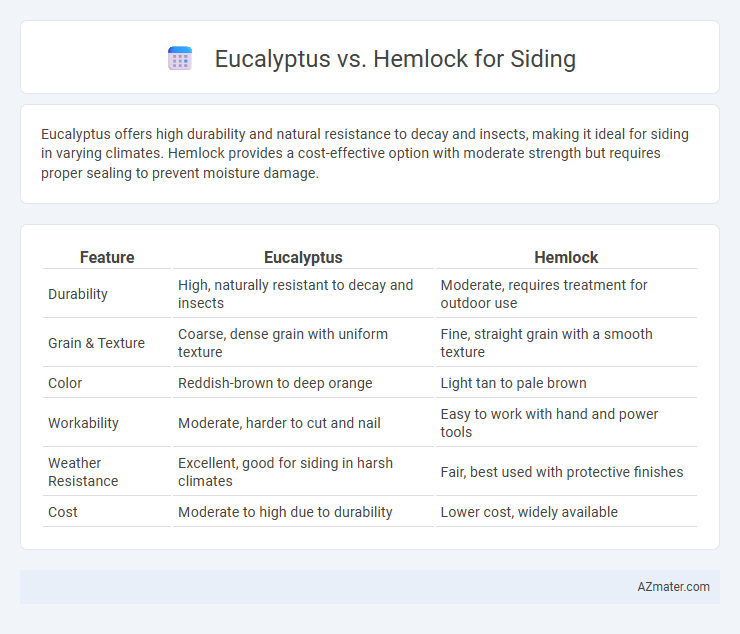Eucalyptus offers high durability and natural resistance to decay and insects, making it ideal for siding in varying climates. Hemlock provides a cost-effective option with moderate strength but requires proper sealing to prevent moisture damage.
Table of Comparison
| Feature | Eucalyptus | Hemlock |
|---|---|---|
| Durability | High, naturally resistant to decay and insects | Moderate, requires treatment for outdoor use |
| Grain & Texture | Coarse, dense grain with uniform texture | Fine, straight grain with a smooth texture |
| Color | Reddish-brown to deep orange | Light tan to pale brown |
| Workability | Moderate, harder to cut and nail | Easy to work with hand and power tools |
| Weather Resistance | Excellent, good for siding in harsh climates | Fair, best used with protective finishes |
| Cost | Moderate to high due to durability | Lower cost, widely available |
Introduction to Eucalyptus and Hemlock as Siding Materials
Eucalyptus and Hemlock are both popular siding materials known for their natural durability and aesthetic appeal. Eucalyptus features tight, dense grain patterns with natural oils that provide resistance to decay and insects, making it suitable for exterior applications. Hemlock offers a fine, uniform texture with excellent dimensional stability, often chosen for its smooth finish and ease of painting or staining in siding projects.
Overview: Characteristics of Eucalyptus Wood
Eucalyptus wood is renowned for its durability, high density, and natural resistance to decay and pests, making it a practical choice for siding applications. The wood features a rich, warm tone with prominent grain patterns that enhance aesthetic appeal while providing strong structural integrity. Its sustainability and fast growth rate contribute to environmental benefits, positioning eucalyptus as an eco-friendly option compared to slower-growing species like hemlock.
Overview: Characteristics of Hemlock Wood
Hemlock wood is valued for its lightweight, straight grain, and fine texture, making it a popular choice for siding due to its ease of workability and smooth finish. It exhibits moderate durability with good resistance to decay in protected applications, but it requires proper treatment and maintenance to withstand harsh weather conditions. Hemlock's pale reddish-brown color offers a natural aesthetic that can be enhanced with stains or sealants to improve longevity and appearance on exterior surfaces.
Durability and Lifespan Comparison
Eucalyptus siding offers exceptional durability due to its dense grain structure and natural resistance to decay, often lasting 25-30 years with proper maintenance. Hemlock siding, while moderately durable, typically endures around 15-20 years and is more susceptible to moisture damage and insect infestation without protective treatments. Choosing eucalyptus siding enhances long-term performance and reduces maintenance frequency compared to hemlock.
Resistance to Weather and Insects
Eucalyptus siding offers superior resistance to weather due to its dense, oily grain structure that naturally repels moisture and withstands harsh climates, reducing the risk of warping or cracking. Hemlock siding, while moderately resistant to weather, is more susceptible to insect damage because of its softer wood fibers and lower natural oils. For long-term durability outdoors, eucalyptus provides enhanced protection against both moisture and insect infestations, making it a more resilient choice for siding applications.
Sustainability and Environmental Impact
Eucalyptus siding offers a rapidly renewable resource with high resistance to pests and decay, contributing to reduced chemical treatments and environmental pollution. Hemlock siding, sourced from slower-growing trees in temperate forests, provides durable wood but often involves longer harvesting cycles, impacting sustainability negatively. Choosing eucalyptus promotes eco-friendly building practices by supporting faster forest regeneration and minimizing deforestation effects compared to traditional hemlock options.
Maintenance Requirements
Eucalyptus siding requires regular sealing and occasional sanding to prevent moisture damage and maintain its natural resistance to insects and decay. Hemlock, being a softer wood, demands more frequent painting or staining and vigilant inspection for rot and insect infestation to ensure longevity. Both materials benefit from periodic cleaning to remove dirt and mildew, but eucalyptus typically offers lower overall maintenance due to its durable, dense grain structure.
Aesthetic Appeal and Design Versatility
Eucalyptus siding offers a rich, warm hue with a smooth grain pattern that enhances modern and contemporary architectural styles, providing a sleek and polished aesthetic appeal. Hemlock siding, characterized by its light, almost pale color and fine, straight grain, lends itself to rustic and traditional designs, offering exceptional design versatility for both interior and exterior applications. Both woods are durable and can be stained or painted, but Eucalyptus stands out for its natural resistance to decay and insect damage, making it a practical choice without sacrificing beauty.
Cost Analysis: Eucalyptus vs Hemlock
Eucalyptus siding generally offers a higher upfront cost compared to Hemlock due to its durability and resistance to pests, which can reduce long-term maintenance expenses. Hemlock provides a more affordable initial investment but may require more frequent treatments to prevent decay and insect damage, potentially increasing overall lifecycle costs. When evaluating cost-effectiveness, factoring in both the purchase price and maintenance expenses over 20 years shows Eucalyptus as a cost-efficient option despite the higher initial price.
Conclusion: Choosing the Best Wood for Siding
Eucalyptus siding offers exceptional durability and natural resistance to moisture and insects, making it ideal for humid or coastal environments. Hemlock provides a smooth texture and uniform grain, favored for its affordability and ease of finishing, but requires more maintenance to prevent decay. Selecting the best wood depends on climate, budget, and desired longevity, with eucalyptus excelling in durability and hemlock in cost-effectiveness.

Infographic: Eucalyptus vs Hemlock for Siding
 azmater.com
azmater.com